|
MASJID AL-AQSA:
Baitu'l Muqaddas
(Jerusalem) houses one of the holiest Mosques, the
Masjid al Aqsa-the Most Distant Mosque-and represents a
place of greatest religious significance to Muslims all
over the world. It is mentioned in the Holy Qur'an
(17:1) as the blessed site where Prophet Muhammad (saws)
was taken on a journey (Miraj)-in the night-to the
heavens. According to Islamic teachings it is one of the
three places to which it is desirable to undertake a
journey (pilgrimage) for the purpose of Salaah
(prayers). The Masjid al Aqsa was the first Qiblah (the
direction to which Muslims faced when praying Salaah).
This continued until 16 to 17 months after Hijrah, when
Allah commanded in His wisdom, for the Muslims to face
Makkah. Traditions also record the merits of performing
the Hajj or Umrah from Masjid al-Aqsa where it is
mentioned "whosoever starts his Hajj and Umrah from
Masjid al-Aqsa, his wrong actions will be forgiven, both
in the past and the future." And, "Paradise will be his
reward." Originally built in 715 CE, the mosque was
reconstructed and enlarged at least six times,
Today, the Mosque of Al-Aqsa
is under Israeli occupation for thirty-seven years, all
Muslims around the world pray for its liberation and for
the freedom of their Palestinian brothers, who have
become the soldiers at the front line of the battle to
redeem Al-Aqsa.
DOME OF THE ROCK:
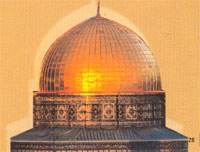
The Qubbat al-Saqarah or
the Dome of the Rock was built by the ninth Caliph Abd
al-Malik ibn Marwan between the years 681 and 691 CE
over a rock (Saqarah), the spot where Prophet Muhammad
(saws) was brought by night and ascended on his journey
to Heavens accompanied by Archangel Jibreel (Gabriel).
It is a holy place to Muslims. Basically unchanged from
the past thirteen centuries, the Dome of the Rock
remains one of the worlds most beautiful and enduring
architectural treasures. The gold covered dome stretches
twenty meters above the Noble Rock rising to a height of
more than thirty-five meters above it with verses of the
Holy Qur'an inscribed across the top in the dazzling
tile work commissioned by the Caliph Sulaiman the
Magnificent in 1520 CE. The place fell into the hands of
the Crusaders in 1122 CE. They cut the Holy Rock into
pieces and covered it with marble slabs and erected an
altar above it after decorating the outer wall with
frescoes. In 1187 CE Sultan Salah ad-Din won the city
for Muslims and restored and regilded the dome removing
the images carved on it. He dismantled the altar and the
marble steps and exposed the bare rock to its original
position. The Dome of the Rock is not a mosque, as it
sometimes wrongly called, is but a station in the outer
court of Masjid al-Aqsa.
PETRA:
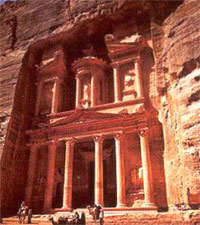
Petra is the name of an
ancient city in Jordan, west of the city of Maan in the
southern part of the country. Rediscovered by J.L
Burckhardt in 1812, it is situated amongst the red
sandstone hills south of the Dead Sea. The rose-red city
of Petra-half as old as time- was once the capital of
Nabateans, the Arab people who dominated this region
before the Romans conquered them. The city was cut into
the rocks with the houses made up of intricate
structures and columns. The approach to the city is
through a ravine, which is less than four meters wide.
The name 'Petra' comes from Greek, and can be translated
as "city of rock". The ruins of Petra include temples,
houses, theatre and tombs all hewn out of the living
rock and the temple of Ed Deir has a magnificently
carved facade, 150 feet long and 138 feet high.
THE RIVER JORDAN:
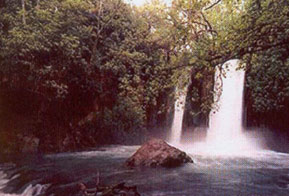
The River Jordan forms the
eastern frontier of the Land of Palestine, and the
sunken valley through which it flows far below the sea
level is a freak of nature. At one point it falls for
seven hundred feet in nine miles and it is here an
immense hydroelectric power station has been
established, which acts as a source of electricity to
the nearby areas.
THE DEAD SEA:
The Dead Sea is forty-six
miles long and eight-and-a-half miles broad. It lies
1,290 feet below sea level.
It receives six-and-a-half million tons of water daily
from the River Jordan, and six other streams, but all of
it is carried by evaporation. It is so rich in mineral
salts and phosphates that fish are unable to live it and
a human body cannot sink below its surface!

BAGHDAD, FABLED CITY OF
THE ARABIAN NIGHTS:
Baghdad has been in
continued existence as a city from the past four
thousand years and during the eighth century it became
under its Arab rulers the seat of the Caliphate and the
emporium of the Middle East. After centuries of decline,
it is again a great city, and the capital of Iraq. The
Khazimain Mosque in the Shia quarter of Baghdad is
famous for its enormous courtyard, and also its golden
domes and minarets.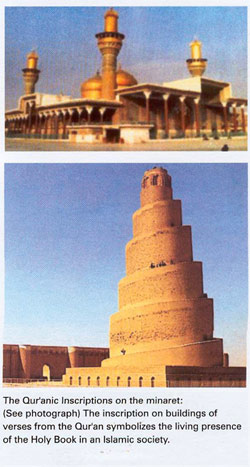
KARBALA
The city of Karbala is
regarded as a holy site by the Shia Muslims. It was here
Imam Husain (r.a), son of Ali (r.a), martyred by the
soldiers of Yazid the Caliph in the year 680 CE. The
city is centered round the mosque of Imam Husain, which
is celebrated for its beautiful design, dome and three
minarets, all of which are gilded.
SAMARRA'S SPIRAL MINARET
Samarra, on the Tigris is
a pilgrim resort. In the ninth century it was the
residence of the Abbasid Caliphs, and its ruins are of
vast importance in the history of Islamic architecture.
The brick minaret of the Mosque of Al-Mutawakkil dates
back to 850 B.C and is remarkable for its external
spiral ramp. This spiral minaret, where the muezzin once
called the faithful to prayer, is the only surviving
feature of the Great Mosque at Samarra, Iraq. At the
time of its construction (848-852), the Great Mosque at
Samarra was the largest Islamic mosque in the world.
YEMEN - SKYSCRAPERS OF
THE DESERT
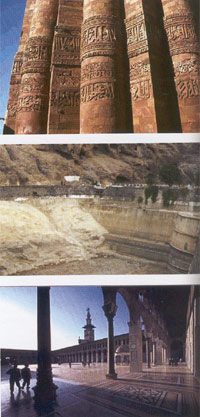
More reminiscent of the
New York skyline than of Shibam the oasis-town of Yemen
in the province of Hadhramaut. It has a town surrounded
by walls. Inside are five hundred houses, like towers,
nine floors high, built of local clay. The town of
Shibam has earned for itself the nickname "Manhattan of
the Desert", because if its mud skyscrapers. Many of
Shibam's skyscrapers have finely engraved wooden doors
with fancy wooden locks; the windows are latticed with
elaborately carved wooden screens. Shibam was twice
destroyed in the 13 th and 16 th century and was last
rebuilt in the year 1553. In the past, many of its
townsfolk immigrated to countries in the Far East for
trade and returned home with vast fortunes and Western
ideas of luxury. The modern skyscrapers are one result.
The town also enjoyed great prosperity for several
centuries as a city on the incense and trade routes of
Southern Arabia. Later, there was a slow decline as many
of Shibam's inhabitants left the town for other
provinces and countries and was almost forgotten until
two English travelers, Mabel and Theodore Bent, visited
it at the end of the 19th century and brought it to the
attention of the West.
ADEN
Aden, garrison port
and fuelling station in Yemen and it lies at the
entrance of the Red Sea. It lies in one of the driest
areas of the world and it depends largely for its vital
water supplies upon a seven-mile long aqueduct carrying
brackish water and upon thirteen tanks built by Arab
engineers of the past with immense skill to harvest
rainwater in the Tawila Gorge. One of the tanks,
modernized by British engineers is seen in the
photographs.
THE GREAT MOSQUE OF
DAMASCUS
The Umayyad Mosque at
Damascus is 430 feet long and 125 feet wide and is well
known throughout the Arab and the Muslim world, rebuilt
at the beginning of the eighth century as a mosque by
the conquering Muslim armies under the command of Khalid
bin Walid from what was originally the site of a church.
The hexagonal fountain in the center of the courtyard is
exactly halfway between Istanbul and Makkah and acts as
the starting point for the pilgrims leaving for Hajj
from Damascus. It is also the place where Yahya (a.s)-John
the Baptist is believed to have been buried.
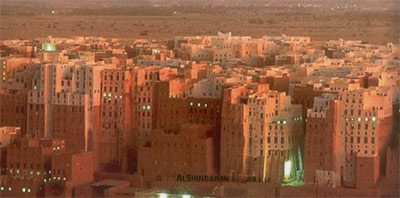
| 